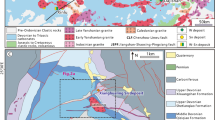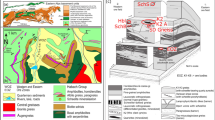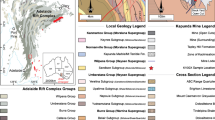Abstract
The Upper Cambrian dolostones in the Tarim Basin are interpreted to be intensely altered by hydrothermal fluids during the burial diagenesis, and the saddle dolomite filled in fractures is commonly considered as hydrothermal origin. In this study, the saddle dolomite samples from drillhole SNP1 and the Quruqtagh area are sampled, and C-O-Sr isotopic compositions and in-situ trace elemental analyses are employed to check their origin. Replaced dolomites with finely crystal size and coarsely crystal size (RD1 and RD2, respectively), and saddle dolomite cements filled in vugs and fractures (VSD and FSD, respectively) are identified in the Well SNP1. Stylolites crosscut RD1 and RD2 dolomites. KZ-SD is the saddle dolomite in hydrothermal dolostone geobodies in the Quruqtagh area, and shows coarsely crystal size up to 1 cm and wavy extinctions. RD1, RD2 and FSD dolomites show similar δ13CVPDB values of − 1.99 to − 0.73‰, and similar 87Sr/86Sr ratios of 0.70868–0.70905. RD1 and RD2 dolomites show δ18OVPDB values of − 8.74 to − 5.29‰ and of − 10.22 to − 9.20‰, respectively. The δ18OVPDB values of FSD range from − 10.94 to − 10.16‰. RD2, VSD and FSD dolomites show Fe concentrations of 154.76–464.65 ppm, Mn concentrations of 15.74–55.93 ppm and REE concentrations of 1.29–4.61 ppm. The REEY profiles of RD2, VSD and FSD dolomites are characterized by flat to convex patterns with slightly MREE enrichment, and no Ce, Eu and Y anomalies. KZ-SD dolomite shows Fe concentrations of 1081.55–1206.35 ppm, Mn concentrations of 427.25–474.38 ppm and REE concentrations of 12.97–23.64 ppm. The C–O–Sr isotopic compositions and REEY features of RD2, FSD and VSD indicate that saddle dolomites filled in vugs and fractures in the Well SNP1 are formed from redistribution of precursor dolostones, and indicate that RD2 may formed by recrystallization during burial diagenesis.











Similar content being viewed by others
Data availability statement
The authors confirm that the data supporting the findings of this study are available within the article.
References
Bau M (1991) Rare-earth element mobility during hydrothermal and metamorphic fluid-rock interaction and the significance of the oxidation state of europium. Chem Geol 93:219–230
Bau M, Balan S, Schmidt K, Koschinsky A (2010) Rare earth elements in mussel shells of the Mytilidae family as tracers for hidden and fossil high-temperature hydrothermal systems. Earth Planetary Ence Lett 299(3–4):310–316
Cai CF, Li KK, Li HT, Zhang BS (2008) Evidence for cross formational hot brine flow from integrated 87Sr/86Sr, REE and fluid inclusions of the Ordovician veins in Central Tarim, China. Appl Geochem 23(8):2226–2235
Davies G, Smith L (2006) Structurally controlled hydrothermal dolomite reservoir facies: an overview. AAPG Bull 90(11):1641–1690
Debruyne D, Hulsbosch N, Muchez P (2016) Unraveling rare earth element signatures in hydrothermal carbonate minerals using a source-sink system. Ore Geol Rev 72:232–252
Dong S, Chen D, Qing H, Zhou X, Wang D, Guo Z, Jiang M, Qian Y (2013) Hydrothermal alteration of dolostones in the Lower Ordovician, Tarim Basin, NW China: multiple constraints from petrology, isotope geochemistry and fluid inclusion microthermometry. Mar Pet Geol 46:270–286
Dong SF, Chen DZ, Zhou XQ, Qian YX, Tian M, Qing HR, Hollis C (2017) Tectonically driven dolomitization of Cambrian to Lower Ordovician carbonates of the Quruqtagh area, north-eastern flank of Tarim Basin, North-West China. Sedimentology 61(4):1079–1106
Du Y, Fan TL, Machel HG, Gao ZQ (2018) Genesis of upper Cambrian-Lower Ordovician dolomites in the Tahe Oilfield, Tarim Basin, NW China: several limitations from petrology, geochemistry, and fluid inclusions. Mar Pet Geol 91:43–70
Ehrenberg S, Bjørlykke K (2016) Comments regarding hydrothermal dolomitization and porosity development in the paper “Formation mechanism of deep Cambrian dolomite reservoirs in the Tarim basin, northwestern China” by Zhu et al. (2015). Mar Pet Geol 76:480–481
Feng M, Wu P, Qiang Z, Liu X, Duan Y, Xia M (2017) Hydrothermal dolomite reservoir in the Precambrian Dengying Formation of central Sichuan Basin, Southwestern China. Mar Pet Geol 82:206–219
Frimmel HE (2009) Trace element distribution in Neoproterozoic carbonates as palaeoenvironmental indicator. Chem Geol 258(3–4):338–353
Gao Z, Fan T (2015) Carbonate platform-margin architecture and its influence on Cambrian-Ordovician reef-shoal development, Tarim Basin, NW China. Mar Pet Geol 68:291–306
Gao S, Wedepohl KH (1995) The negative Eu anomaly in Archean sedimentary rocks: Implications for decomposition, age and importance of their granitic sources. Earth Planet Sci Lett 133:81–94
Gong Q, Li F, Lu C, Wang H, Tang H (2021) Tracing seawater- and terrestrial-sourced REE signatures in detritally contaminated, diagenetically altered carbonate rocks. Chem Geol 570:120169
Guo C, Chen D, Qing H, Dong S, Li G, Wang D, Qian Y, Liu C (2016) Multiple dolomitization and later hydrothermal alteration on the Upper Cambrian-Lower Ordovician carbonates in the northern Tarim Basin, China. Mar Pet Geol 72:295–316
Haas J, Shock E, Sassani D (1995) Rare earth elements in hydrothermal systems : estimates of standard partial molal thermodynamic properties of aqueous complexes of the rare earth elements at high pressures and temperatures. Geochim Cosmochim Acta 59(21):4329–4350
Hirani J, Bastesen E, Boyce A, Corlett H, Gawthorpe R (2018a) Controls on the formation of stratabound dolostone bodies, Hammam Faraun Fault block, Gulf of Suez. Sedimentology 65(6):1973–2002
Hirani J, Bastesen E, Boyce A, Corlett H, Eker A, Gawthorpe R, Hollis C, Korneva I, Rotevatn A (2018b) Structural controls on non-fabric-selective dolomitization within rift-related basin-bounding normal fault systems: insights from the Hammam Faraun Fault, Gulf of Suez, Egypt. Basin Res 30:990–1014
Hollis C, Bastesen E, Boyce A, Corlett H, Gawthorpe R, Hirani J, Rotevatn A, Whitaker F (2017) Fault-controlled dolomitization in a rift basin. Geology 45(3):219–222
Hu Z, Hu W, Liu C, Sun F, Liu Y, Li W (2019) Conservative behavior of Mg isotopes in massive dolostones: from diagenesis to hydrothermal reworking. Sed Geol 381:65–75
Huang QY, Liu D, Ye N, Li YT (2013) Reservoir characteristics and diagenesis of the Cambrian dolomite in Tarim basin. J Northeast Pet Univ 37(6):63–74 ((in Chinese with English abstract))
Huang B, Zhang S, Lu Z, Ye N, Zhu B, Ding X, Li Y (2021) Origin of dolomites in Lower-Middle Ordovician carbonate rocks in the Yingshan Formation, Gucheng Area, Tarim Basin: Evidence from petrography and geochemical data. Mar Petrol Geol. https://doi.org/10.1016/j.marpetgeo.2021.105322
Jia CZ, Wei GQ (2002) Structural characteristics and petroliferous features of Tarim Basin. Chin Sci Bull 47:1–11
Jiang L, Cai CF, Worden RH, Crowley SF, Jia LQ, Zhang K, Duncan IJ (2016) Multiphase dolomitization of deeply buried Cambrian petroleum reservoirs, Tarim Basin, North-West China. Sedimentology 63(7):2130–2157
Jiao C, He Z, Xing X, Qing H, He B, Li C (2011) Tectonic hydrothermal dolomite and its significance of reservoirs in Tarim basin. Acta Petrol Sin 27(1):277–284
Koeshidayatullah A, Corlett H, Stacey J, Swart PK, Boyce A, Robertson H, Whitaker F, Hollis C (2020a) Evaluating new fault-controlled hydrothermal dolomitization models: insights from the Cambrian Dolomite, Western Canadian sedimentary basin. Sedimentology 67:2945–2973
Koeshidayatullah A, Corlett H, Stacey J, Swart PK, Boyce A, Hollis C (2020b) Origin and evolution of fault-controlled hydrothermal dolomitization fronts: a new insight. Earth Planet Sci Lett 541:116291
KučEra J, Cempírek J, DolníčEk Z, Muchez P, Prochaska W (2009) Rare earth elements and yttrium geochemistry of dolomite from post-Variscan vein-type mineralization of the Nízk Jeseník and Upper Silesian Basins, Czech Republic. J Geochem Explor 103(2–3):69–79
Li F, Webb GE, Algeo TJ, Kershaw S, Lu CJ, Oehlert AM, Gong QL, Pourmand A, Tan XC (2019) Modern carbonate ooids preserve ambient aqueous REE signatures. Chem Geol 509:163–177
Ling HF, Chen X, Li D, Wang D, Shields GA, Zhu MY (2013) Cerium anomaly variations in Ediacaran–earliest Cambrian carbonates from the Yangtze Gorges area, South China: Implications for oxygenation of coeval shallow seawater. Precambr Res 225:110–127
Liu P, Deng S, Guan P, Jin Y, Wang K, Chen Y (2020) The nature, type, and origin of diagenetic fuids and their control on the evolving porosity of the Lower Cambrian Xiaoerbulak Formation dolostone, northwestern Tarim Basin, China. Pet Sci 4:873–895
Lonnee J, Machel H (2006) Pervasive dolomitization with subsequent hydrothermal alteration in the Clarke Lake gas field, Middle Devonian Slave Point Formation, British Columbia, Canada. AAPG Bull 90(11):1739–1761
Lu Z, Chen H, Qing H, Chi G, Chen Q, You D, Yin H, Zhang S (2017) Petrography, fluid inclusion and isotope studies in Ordovician carbonate reservoirs in the Shunnan area, Tarim basin, NW China: implications for the nature and timing of silicification. Sed Geol 359:29–43
Lu Z, Li Y, Zhang S, Ye N, Zhu B, Lu C, Ding X, Huang B (2021) Tracing fault-related fluids using in situ trace elements: a case study in Upper Cambrian dolostone in Gucheng area, Tarim Basin, NW China. Geol J. https://doi.org/10.1002/gj.4105
Machel HG (1987) Saddle dolomite as a by-product of chemical compaction and thermochemical sulfate reduction. Geology 15(10):1301–1306
Machel HG (2004) Concepts and models of dolomitization: a critical reappraisal. Geol Soc Lond Spec Publ 234(1):7–63
Machel HG, Lonnee J (2002) Hydrothermal dolomite—a product of poor definition and imagination. Sed Geol 152(3):163–171
Machel HG, Cavell PA, Patey KS (1996) Isotopic evidence for carbonate cementation and recrystallization, and for tectonic expulsion of fluids into the Western Canada Sedimentary Basin. Geol Soc Am Bull 108(9):1108–1119
Machel HG, Cavell PA, Buschkuehle BE, Michael K (2000) Tectonically induced fluid flow in Devonian carbonate aquifers of the Western Canada Sedimentary Basin. J Geochem Explor 69–70:213–217
McLennan SM (1989) Rare earth elements in sedimentary rocks: influence of provenance and sedimentary processes. Rev Mineral Geochem 21(1):169–200
Migdisov AA, Williams-Jones AE, Wagner T (2009) An experimental study of the solubility and speciation of the Rare Earth Elements (III) in fluoride- and chloride-bearing aqueous solutions at temperatures up to 300°C. Geochim Cosmochim Acta 73:7087–7109
Migdisov AA, Williams-Jones AE, Brugger J, Caporuscio FA (2016) Hydrothermal transport, deposition, and fractionation of the REE: Experimental data and thermodynamic calculations. Chem Geol 439:13–42
Möller P (2002) Rare earth elements and yttrium in geothermal fluids. In: Stober IB (ed) Water science and technology library, vol 40, pp 97–125
Morrow D, Immenhauser A (2014) Zebra and boxwork fabrics in hydrothermal dolomites of northern Canada: indicators for dilational fracturing, dissolution orin situreplacement? Sedimentology 61(4):915–951
Nothdurft LD, Webb GE, Kamber BS (2004) Rare earth element geochemistry of Late Devonian reefal carbonates, Canning Basin, Western Australia: confirmation of a seawater REE proxy in ancient limestones. Geochim Cosmochim Acta 68:263–283
Paton C, Hellstrom J, Paul B, Woodhead J, Hergt J (2011) Iolite: Freeware for the visualisation and processing of mass spectrometric data. J Anal Spectrom 26:2508
Qian Y, You D, Chen D, Qing H, He Z, Ma Y, Tian M, Xi B (2012) The petrographic and geochemical signatures and implication of origin of the Middle and Upper Cambrian dolostone in eastern margin Tarim: Comparative studies with the Whirlpool point of the Western Canada Sedimentary Basin. Acta Petrol Sin 28(8):2525–2541
Qing HR, Chen DZ (2010) Non-hydrothermal Saddle dolomite: petrological and geochemical evidence from the Ordovician Yeoman formation, Southeastern Saskatchewan, Canada. Acta Sedimentol Sin 28(5):980–986
Qing H, Mountjoy E (1992) Large-scale fluid-flow in the middle Devonian Presquile barrier, Western Canada sedimentary basin. Geology 20(10):903–906
Qing HR, Mountjoy EW (1994) Formation of coarsely crystalline, hydrothermal dolomite reservoirs in the Presqu’ile barrier, Western Canada sedimentary basin. AAPG Bull 78(1):55–77
Rieger P, Magnall J, Gleeson S, Oelze M, Wilke F, Lilly R (2021) Differentiating between hydrothermal and diagenetic carbonate using rare earth element and yttrium (REE+Y) geochemistry: a case study from the Paleoproterozoic George Fisher massive sulfide Zn deposit, Mount Isa, Australia. Miner Deposit. https://doi.org/10.1007/s00126-021-01056-1
Shields G, Stille P (2001) Diagenetic constraints on the use of cerium anomalies as palaeoseawater redox proxies: an isotopic and REE study of Cambrian phosphorites. Chem Geol 175:29–48
Stacey J, Hollis C, Corlett H, Koeshidayatullah A (2020) Burial dolomitization driven by modified seawater and basal aquifer-sourced brines: insights from the Middle and Upper Devonian of the Western Canadian Sedimentary Basin. Basin Res 33:648–680
Stacey J, Corlett H, Holland G, Koeshidayatullah A, Cao C, Swart P, Crowley S, Hollis C (2021) Regional fault-controlled shallow dolomitization of the Middle Cambrian Cathedral Formation by hydrothermal fluids fluxed through a basal clastic aquifer. Geol Soc Am Bull. https://doi.org/10.1130/B35927.1
Tostevin R, Shields GA, Tarbuck GM, He TC, Clarkson MO, Wood RA (2016) Effective use of cerium anomalies as a redox proxy in carbonate-dominated marine settings. Chem Geol 438:146–162
Webb GE, Kamber BS (2000) Rare earth elements in Holocene reefal microbialites: a new shallow seawater proxy. Geochim Cosmochim Acta 64(9):1557–1565
Wei D, Gao Z, Fan T, Niu Y, Guo R (2021) Volcanic events-related hydrothermal dolomitization and silicification controlled by intra-cratonic strike-slip fault systems: insights from the northern slope of the Tazhong Uplift, Tarim Basin, China. Basin Res 2021:1–24
Xu Z, Li S, Zhang J, Yang J, He B, Li H, Lin C, Cai Z (2011) Paleo-Asian and Tethyan tectonic systems with docking the Tarim block. Acta Petrol Sin 27(1):1–22
Zhang J, Hu W, Qian Y, Wang X, Cao J, Zhu J, Li Q, Xie X (2009) Formation of saddle dolomites in Upper Cambrian carbonates, western Tarim Basin (northwest China): Implications for fault-related fluid flow. Mar Pet Geol 26(8):1428–1440
Zhang C, Zou H, Li H, Wang H (2013) Tectonic framework and evolution of the Tarim Block in NW China. Gondwana Res 23(4):1306–1315
Zhang W, Guan P, Jian X, Feng F, Zou CN (2014) In situ geochemistry of Lower Paleozoic dolomites in the northwestern Tarim basin: implications for the nature, origin, and evolution of diagenetic fluids. Geochem Geophys Geosyst 15(7):2744–2764
Zhao WZ, Shen AJ, Hu SY, Pan WQ, Zheng JF, Qiao ZF (2012) Types and distributional features of Cambrian-Ordovician dolostone reservoirs in Tarim Basin, northwestern China. Acta Petrol Sin 28(3):758–768
Zhu DY (2016) Discussion for comments of Ehrenberg and Bjørlykke on paper “Formation mechanism of deep Cambrian dolomite reservoirs in the Tarim basin, northwestern China.” Mar Pet Geol 76:478–479
Zhu DY, Meng QQ, Jin ZJ, Liu QY, Hu WX (2015) Formation mechanism of deep Cambrian dolomite reservoirs in the Tarim basin, northwestern China. Mar Pet Geol 59:232–244
Acknowledgements
This research was supported by the Fund of the State Key Laboratory of Shale Oil and Gas Enrichment Mechanisms and Effective Development (No. 33550007-21-ZC0613-0009), the NSFC Basic Research Program on Deep Petroleum Resource Accumulation and Key Engineering Technologies (No. U19B6003), and the National Natural Science Foundation of China (No. 42102191). Special thanks go to Dr. Tan Xiucheng and Dr. Zhao Dongfang of the Laboratory of Carbonate Sedimentary and Diagenetic Geochemistry for collection and analyses of the in-situ trace elemental data.
Author information
Authors and Affiliations
Corresponding authors
Ethics declarations
Conflict of interest
The authors declare that they have no known competing financial interests or personal relationships that could have appeared to influence the work reported in this paper.
Additional information
Publisher's Note
Springer Nature remains neutral with regard to jurisdictional claims in published maps and institutional affiliations.
Rights and permissions
About this article
Cite this article
Ziye, L., Yingtao, L., Mingming, L. et al. Non-hydrothermal saddle dolomite in Upper Cambrian dolostones of Tarim Basin: evidence from C–O–Sr isotopic and in-situ trace elemental studies. Carbonates Evaporites 37, 54 (2022). https://doi.org/10.1007/s13146-022-00799-w
Accepted:
Published:
DOI: https://doi.org/10.1007/s13146-022-00799-w




